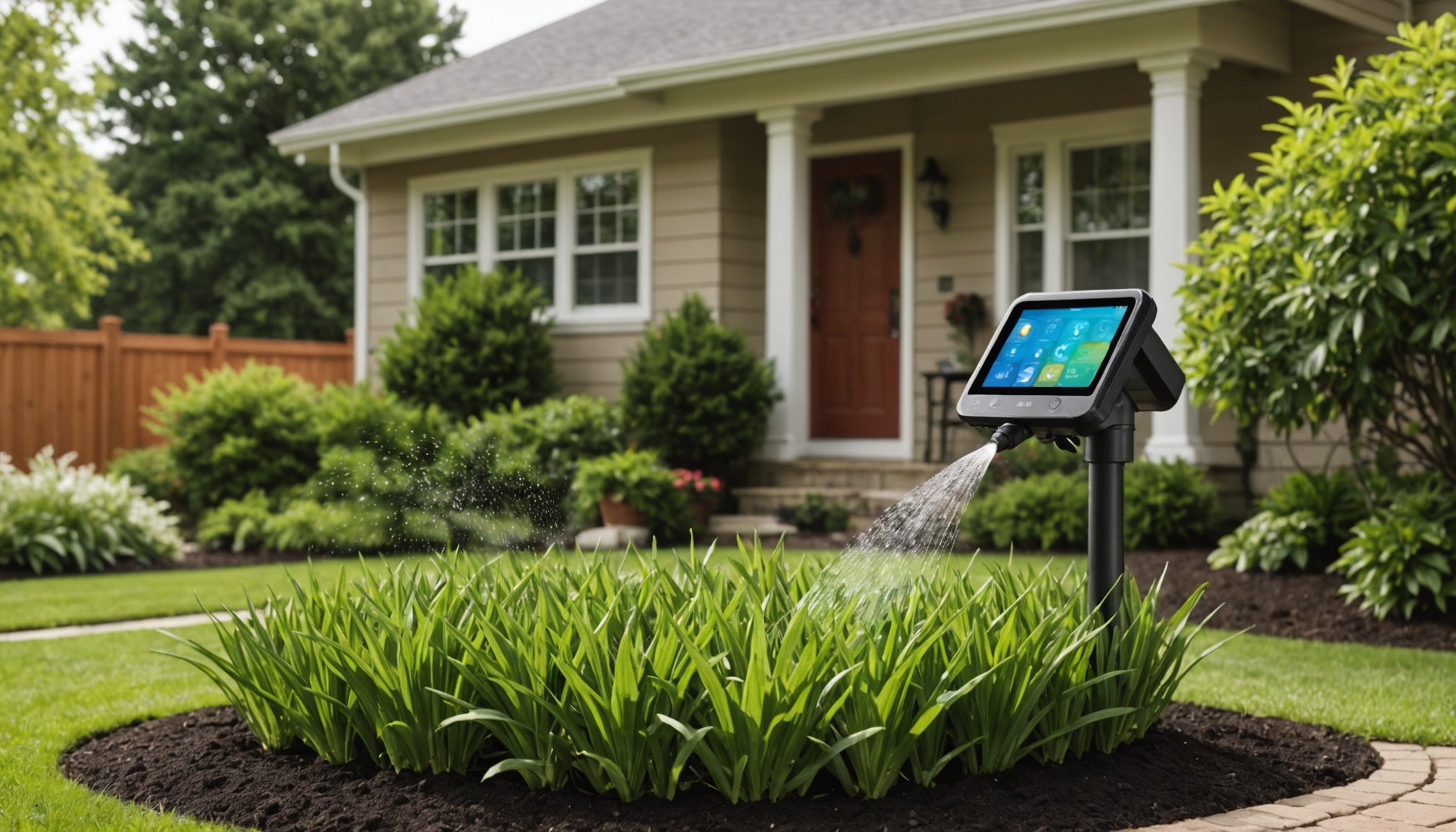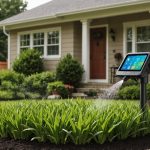Understanding Smart Irrigation Technology
Smart irrigation systems are revolutionising home gardening with advanced automation and intuitive control. At the heart of smart watering technology lies a combination of sensors, weather data, and IoT connectivity. These systems adjust watering schedules based on real-time weather conditions, enhancing the efficiency of irrigation automation. If weather forecasts predict rain, the system automatically reduces watering, preventing over-saturation and conserving water.
The primary advantage of adopting smart watering technology is the significant improvement in water usage efficiency. This ensures that plants receive optimal moisture levels, promoting lush growth while reducing water waste. Moreover, users can remotely manage and customise their irrigation schedules through apps, granting unparalleled convenience and control.
Topic to read : Ultimate guide to controlling your air conditioner via smartphone for unmatched smart home comfort
A typical smart irrigation setup comprises several key components. These include moisture sensors, which gauge soil wetness; weather sensors, which adjust scheduling in response to climate changes; and a sophisticated control system that processes data and automates watering routines. Upgrading to a smart irrigation system not only caters to sustainability-conscious gardeners but also simplifies the complexities of lawn maintenance, with the systems providing proactive care that fits any homeowner’s busy schedule. Overall, embracing this technology can transform both everyday gardening and larger agricultural endeavours.
Smartphone Apps for Smart Irrigation Control
The evolution of irrigation apps has transformed how users manage their watering systems. Smartphone control provides intuitive interfaces, enabling users to adjust settings from anywhere, ensuring optimal plant health.
Features of Leading Irrigation Apps
Cutting-edge irrigation apps offer diverse features like scheduling, weather-based adjustments, and real-time monitoring. Many also provide water usage analytics, allowing users to make informed changes for increased efficiency. Some apps support voice control through integration with digital assistants, adding further convenience.
Compatibility with Smart Devices
App integration is crucial, and leading irrigation apps boast compatibility with various smart devices and ecosystems. Integrating with systems like Google Home, Amazon Alexa, and Apple HomeKit, these apps synchronize seamlessly, allowing users to reinforce their smart home network without hassle.
User Reviews and Ratings
User feedback is an invaluable resource in assessing irrigation apps. Reviews highlight user preferences, such as interface ease, reliability, and tech support. Positive ratings often emphasize simple smartphone control and effective app integration, guiding potential buyers towards the best options. Some common user praise includes responsive customer service and regular updates enhancing app functionality.
Setting Up Your Smart Irrigation System
Embarking on the journey of installing a smart irrigation system can transform the way you manage your garden’s needs. Start with the installation guide, providing step-by-step instructions to simplify the process.
First, gather the necessary tools. You’ll generally need a drill, a screwdriver, and cable ties. With your tools in hand, follow the system setup instructions provided by your device manufacturer.
Most systems include:
- A control unit
- Valves
- Rain sensors
- Moisture sensors
Begin by attaching the control unit to a convenient location, such as a garage wall. Ensure it’s within range of your Wi-Fi for seamless integration.
The next step is irrigation configuration. Connect the valves to your existing sprinkler lines. This step is crucial for optimising water flow and ensuring efficient distribution across your garden.
Once you’ve physically set up the system, it’s time to connect it to your smartphone app. This requires linking the device to your Wi-Fi network and downloading the relevant app. Enter any identification codes like model numbers as directed by the app instructions.
Ensure all connections are waterproof and robust to withstand varying weather conditions. A properly configured smart irrigation system enhances plant care while conserving water.
Optimizing Watering Schedules
Creating an efficient watering schedule is crucial for maintaining healthy plants and conserving resources. By optimizing irrigation based on several factors, you can ensure that your garden thrives without unnecessary water wastage.
Factors Influencing Watering Needs
The requirement for water varies significantly depending on several elements, including soil type, plant variety, and seasonal changes. Sandy soils, for instance, drain water faster, necessitating more frequent irrigation. Conversely, clay soils retain moisture longer, reducing the frequency needed. Different plant species also have unique water needs; for instance, succulents require less frequent watering compared to thirsty tropical plants.
Using Weather Data for Smart Scheduling
Smart watering schedules utilize real-time weather data to optimize water usage. Rain forecasts and humidity levels directly influence when and how much to water. Leveraging this data helps in conserving water by avoiding unnecessary irrigation on rainy days or adjusting schedules during dry spells, promoting healthier plant growth and reducing waste.
Customizing Settings for Different Plant Types
Tailoring irrigation settings to match the specific requirements of various plants ensures optimal growth. By categorizing plants based on their water needs—such as drought-resistant versus water-loving varieties—you can create targeted watering regimens. This customization fosters plant health and improves water efficiency, offering a robust solution to garden care.
Comparing Different Smart Irrigation Systems
Navigating the smart irrigation market can be challenging with various options available. Let’s dive into a system comparison to determine the best smart irrigation for your needs.
Brand and Feature Comparison
Top brands offer diverse features, catering to different landscaping needs. Systems like Rachio and Rain Bird provide extensive weather adaptability, helping preserve water and optimize costs. Others, such as Orbit and Netro, emphasize user-friendly interfaces. When considering best smart irrigation, evaluate features like scheduling flexibility, smartphone control, and water usage monitoring. These will help tailor the irrigation process to specific garden requirements.
Wired vs. Wireless Systems
A critical comparison lies between wired and wireless configurations. Wireless systems offer easy installation and flexibility, perfect for retrofitting existing landscapes. These systems often support integration with smart home devices, enhancing convenience. Conversely, wired systems can be more reliable in areas with fluctuating internet connectivity, ensuring consistent operation.
Price and Value
Smart irrigation systems range dramatically in price, from budget-friendly options to high-end models. Cheaper models may lack advanced features, while pricier ones offer comprehensive weather analysis and customization. Assessing value involves a balance between cost and functionality—investing slightly more may result in significant savings on your water bill long-term. Consider your specific needs and budget when exploring market options.
Troubleshooting Common Issues
Every smart irrigation system occasionally faces hitches, requiring effective troubleshooting tips to ensure efficient operation.
Common Problems and Solutions
One frequent issue users encounter is inconsistent water distribution. This usually results from clogged emitters or misconfigured settings. First, check the system settings and adjust them to align with local weather conditions. Cleaning the emitters can resolve blockage issues, improving water flow. If schedules don’t trigger, verify power sources and connectivity.
Regular Maintenance Tasks
To maintain your system’s longevity, focus on regular upkeep. Clean filters monthly to prevent blockages. Calibrate sensors seasonally to ensure accurate soil moisture readings. Regularly inspect hoses for leaks that lead to water wastage. These maintenance efforts prevent small issues from becoming significant.
When to Seek Professional Help
Despite best efforts, some system issues demand professional intervention. If water pressure remains low post-troubleshooting or if electronic components fail to respond, a specialist is needed. Recognising such signs early prevents system damage. Professionals offer experience and expertise in handling complex problems, thus safeguarding system efficiency.
Water Conservation Benefits of Smart Irrigation
Smart irrigation systems present a revolutionary approach to achieving significant water savings in eco-friendly gardening. Embracing such technology dramatically impacts conservation efforts, enabling gardeners to utilise water more efficiently. With the increasing threat of global water shortages, adopting smart technology is not only practical but essential.
Numerous studies underscore the effectiveness of smart irrigation in reducing water usage. For instance, data shows that smart systems can decrease water consumption by up to 50%, without compromising landscape health. The programmed precision ensures that plants receive the exact amount needed, minimising waste.
Integrating these solutions encourages sustainable gardening practices. By automating irrigation, water is utilised optimally based on weather patterns and soil moisture levels—further reinforcing eco-friendly actions.
Encouraging Practices
- Educate gardeners on technology benefits.
- Promote widespread adoption through incentives.
- Foster community involvement in sustainable efforts.
Ultimately, smart irrigation offers a dual advantage: preserving valuable water resources while maintaining lush, vibrant gardens. This eco-friendly solution highlights the transformative power of technology in fostering sustainability. As gardeners, adopting such practices places us at the forefront of conservation, ensuring resources for future generations while enjoying thriving landscapes today.











